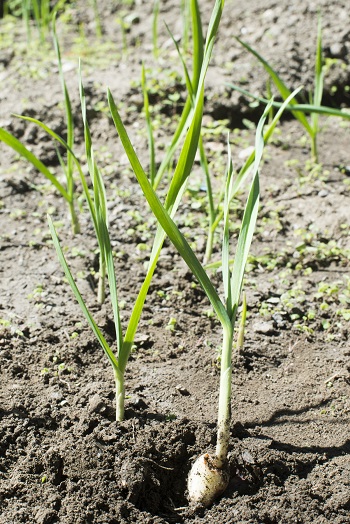Every gardener can harvest garlic from their garden and it is easy to grow if it is grown at the right time of year. Garlic is best grown during the months when tomatoes and summer vegetables have vacated the garden space. In some areas, garlic can be harvested before these summer vegetables require the space.
Garlic is an ingredient for many different dishes. Not only can we use the cloves, but we can use the greens or chives in cooking and salads as well. A juice made of garlic cloves and leaves can also be used as an insect repellent for the garden.
Types of Garlic
There are two types of garlic, the soft neck and the hard neck. Hard neck is also known as “seed stem” because in the late spring just before bulb expansion, the plant shoots up a flower stem. This needs to be removed for the best bulb yields. Hard-neck yields larger cloves, tastes better, but can be hard to keep from sprouting if it is placed in long-term storage. Soft-neck is what is found in most grocery stores. It stores better, is easier to grow in warmer climates and has a slightly higher yield. The cloves in soft-neck are more difficult to divide.
How to Grow Garlic
- Plant in the fall at the same time when spring flowering bulbs like daffodils, crocuses and tulips are planted.
- Planting depth is 1-2 inches deep.
- Distance between plants: 1-2 inches apart.
- Mulch after planting to stabilize winter ground temperatures.
- In spring, remove seed heads as they develop so the bulbs will continue to grow.
- Harvest when leaves begin to turn brown.
- It is easiest to braid when some green remains on the stems.
Garlic for Planting
Garlic seed can be bought many places, but planting bulbs is easier and produces better results. Do not use soft-neck garlic from the grocery store. It will not work because it has been treated with an anti-sprouting chemical. It is easiest to get your first garlic from a reputable seed company either online or through a catalog.
Planting Garlic
The best time to plant is in the autumn after the first frost, but before the first hard freeze, about the time early spring flowering bulbs like daffodils or tulips are planted. Spring planted garlic does not do as well as garlic planted in the autumn.

Garlic grows best in deep rich soil and in the full sun. Do not plant it in a garden bed that was recently vacated; build a new bed instead, in the spring if possible. To build a new bed, create a 4 x 8 foot box with untreated lumber or brick or stones. You may loosen the soil inside the box, but you don’t have to do that. Simply lay out a thick layer of newspapers or cardboard at the bottom of the bed and cover it with yard wastes like leaves and small sticks to hold the newspapers or cardboard in place and water thoroughly.
Add any soil left from transplanting other plants into the garden and keep it well-watered. Add grass clippings but never use grass clippings from the yard if you use herbicides or pesticides in your garden. The materials you add will decompose during the summer. Stop adding new materials when summer is about half over so the compost will have time to decompose before the garlic is planted. Keep the bed well-watered and fill it with soil about two weeks before you intend to plant. Never walk on the garden bed.
Select large, healthy cloves and press them into the soil, about 1-2 inches deep. Space them about 4 to 6 inches apart and in all directions. Be sure to plant the garlic with the root end down. A 4 x 8 foot bed will normally produce enough garlic for eating and canning to last a family of four for a year.
When the ground is frozen, mulch the garlic bed to help prevent frost heaves and reduce weed growth in the spring. Autumn leaves that have been run through the lawn mower work well. Be sure to provide the garlic with extra water during dry periods.
Harvesting Garlic
Once the leaves begin to turn brown, check the plants frequently. Let the plants grow as long as possible but do not leave it so long that the bulbs shatter and reduce the storage ability of the garlic. Cure it in a hot dry dark place that has good circulation for a few weeks. Trim the roots and neck or braid it if you wish.
Use any bulbs that shattered first. This garlic is good for using in canning and pickling. Save the biggest of the garlic cloves that do not store well to plant the next year’s garlic crop. They are fine for this purpose. Garlic can be replanted year after year without difficulty.
Garlic is a member of the onion family (allium sativum) and has a distinguished history. It is packed with nutrients, provides a powerful antioxidant and contributes deliciously to a meal.
Donna Brown is the author of the gardening book Simply Vegetable Gardening.
Related Articles & Free Email Newsletter Sign Up
Garlic is a Must for the Cook’s Garden
Garlic Should be Part of Your Winter Greenhouse Garden




Comment here